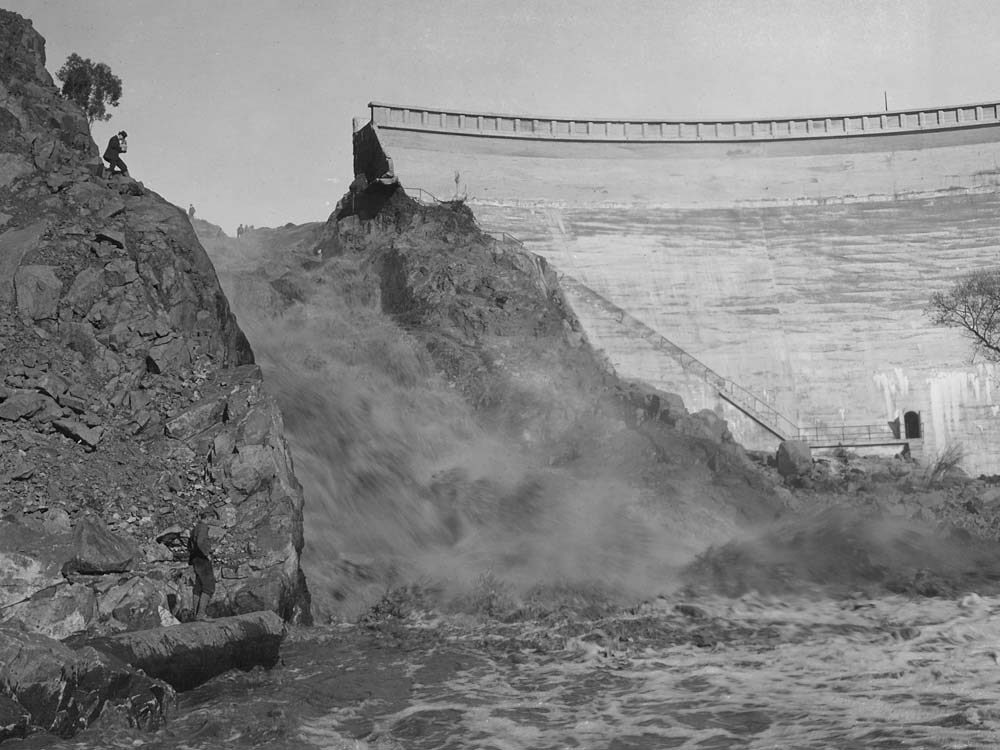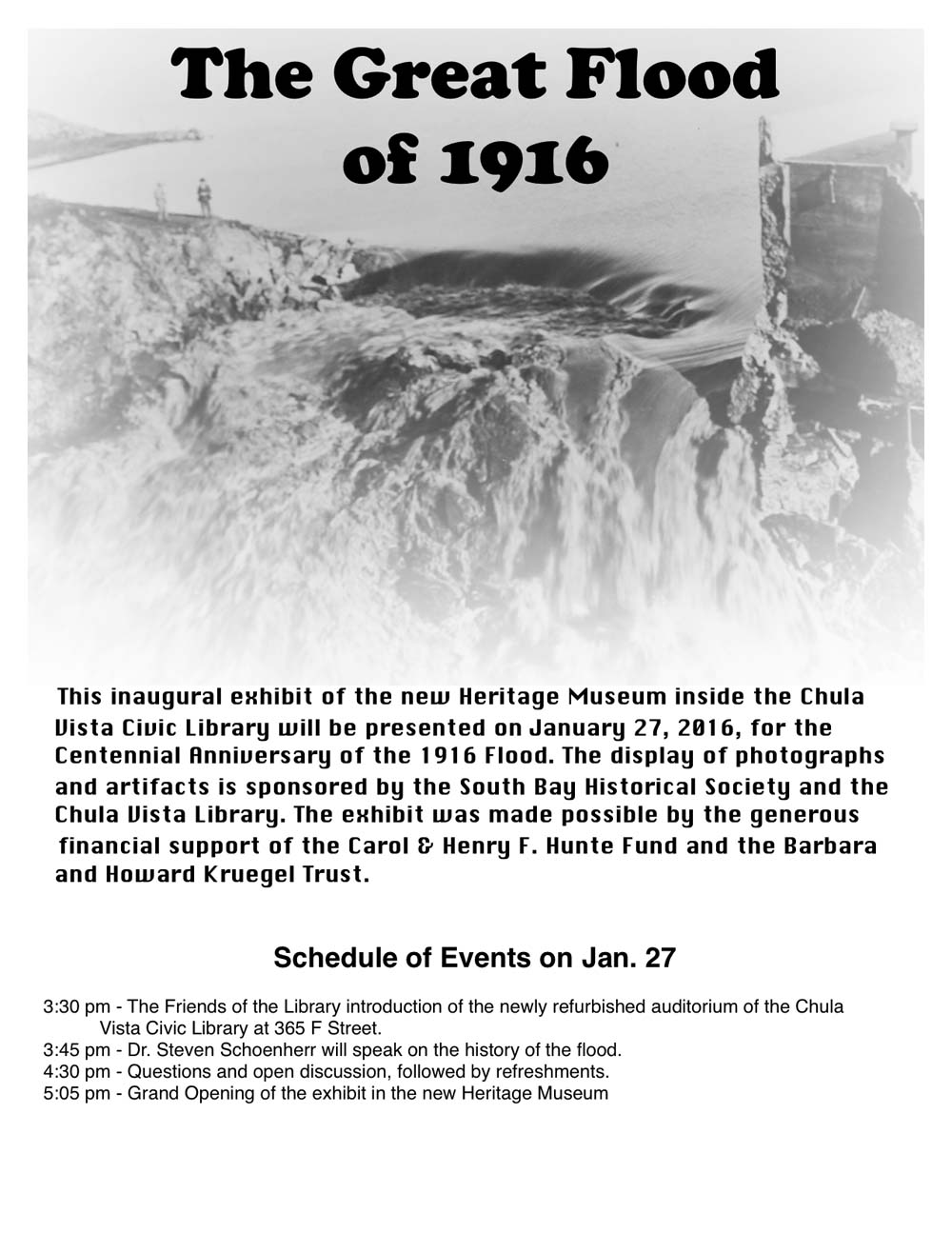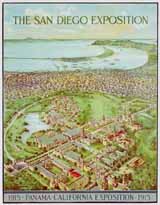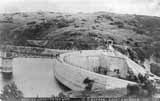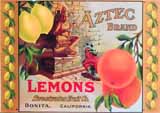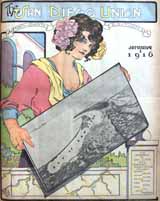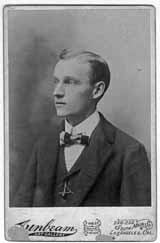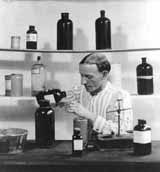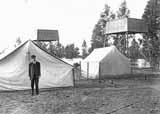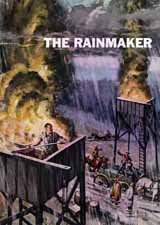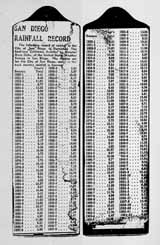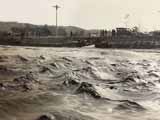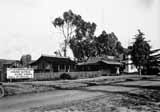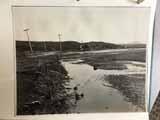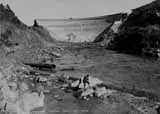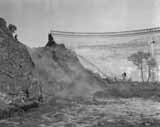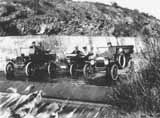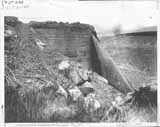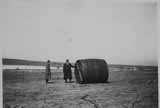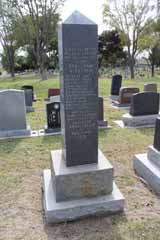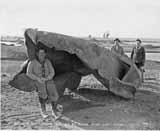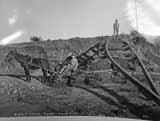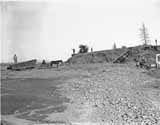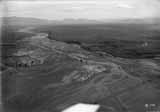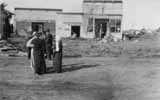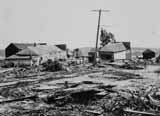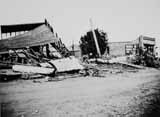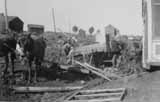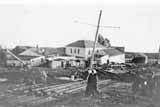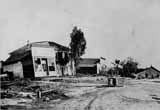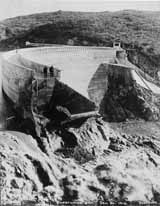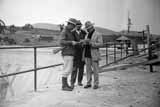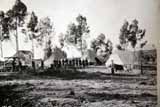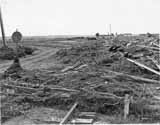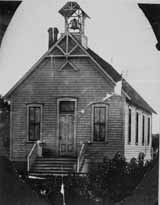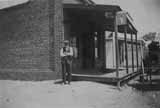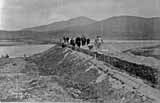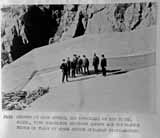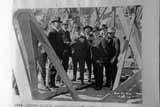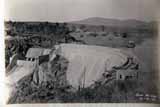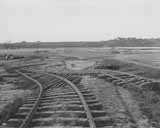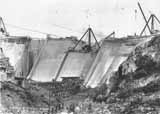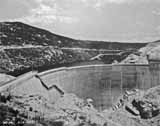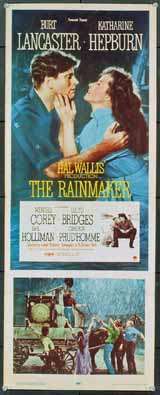|
The Great Flood of 1916
by Steve Schoenherr
The break in the Sweetwater Dam south abutment was photographed on Jan. 30.
The flood of 1916 was the worst natural disaster in the history of the South Bay. It has been blamed on Charles Hatfield, the infamous rainmaker who erected platforms near the Morena Reservoir Jan. 1, 1916, sending chemicals into the air that produced the rain that ended a four-year drought. Hatfield was not the only cause. The Weather Bureau said the rain came from several Pacific storms that converged at the same time on San Diego, an early version of today's El Niño. Hatfield and the storms caused a massive amount of rain to fall during the last two weeks in January, more than has ever been recorded for two weeks in the history of the South Bay. All the river canyons in the county were flooded and every bridge destroyed. The Otay dam broke and a wall of water flooded the entire valley, destroying the town of Otay, the Salt Works and hundreds of farms. Eleven Japanese farmers living below the dam were killed, The flood carried debris and topsoil into San Diego Bay, forming shoals that filled the south end of the bay blocking ship channels for years. The Tijuana River flood destroyed the town of Tijuana and the utopian village of Little Landers. The rain filled the Sweetwater Reservoir until the abutment below the dam gave way, unleashing a torrent of water that rushed into the valley. The earthen dike on the low side of the reservoir also broke, sending another flood of water down the canyon past Central Avenue. The water pipelines in the valley from the Sweetwater reservoir were destroyed, and there was no drinking water in the South Bay for the next three weeks. The railroad in the valley was destroyed, as were the bridges at Willow Street, Edgemere Road, Highland and National Avenues. The Friend's Church washed away and the Sunnyside school was damaged. The Sweetwater Woman's Club house and all its contents, including the local library, were carried into the bay. The adobe walls of the Old Red Barn packinghouse dissolved, leaving only a skeleton building. The gardens and fields of Chinese workers who helped build the dam in 1888 were destroyed. After the flood, the Lower Otay Dam was rebuilt and more dams were added to the South Bay watersheds, including Barrett in 1922, Rodriguez in 1936, Judson in 1937 and Loveland in 1945. These dams improved the water supply but did not prevent flooding, as recently as 1993 and 2008.
Water System Expanding. In August of 1912 the voters approved bonds for the purchase of the water facilities which it was said would provide the city with a municipally-owned system from "mountain to meter." Morena Dam construction was resumed after work had been halted in 1898. The 150-foot Morena dam, 63 miles east of San Diego, was completed in 1912. The officials of San Diego contracted for a supply of water and took a 10-year option to purchase the property and all water rights. In 1913 the City of San Diego voted a $1,500,000 bond issue and in 1914 took up their option and purchased Lake Morena. Spreckels sold Morena Dam to city of San Diego for $1.5m to raise cash for the railroad, plus Spreckels borrowed $1.4 million from banks to finish construction of SD&A railroad by 1919. ( Desert, The Magazine of the West, Feb. 1965)
California Ranks Fifth In Salt Production. The production of salt at the Western Salt Company's big plant on the bay west of Fairfield, a Chula Vista tract, is rapidly increasing each year. California ranks fifth in the production of salt in the United States and, although the industry of extracting solar-salt from ocean water in this state began at San Francisco in the early days of the gold rush, San Diego is rapidly overtaking its northern rival and bids fair to become the salt producing center of the Pacific coast. Its output for 1916 Is expected to run from 50,000 to 60,000 tons or one third of the solar-salt output between Mexico and Canada. (San Diego Union Jan. 1, 1916) Yacht Club Adds To City's Gaiety. Prosperous Chula Vista Aquatic Organization Captures Many Trophies. It was only natural that with the best equable facilities in the world, with a bay covering an area of twenty-two square miles, land-locked and ever smooth, with a climate that permits boating 365 days in the year, that Chula Vista would take advantage of these opportunities and organize a yachting club. The club, which was founded a number of years ago, has a large membership with comfortable and convenient quarters on an acre of land right on the bay front. The fleet, which is a large one, comprises some of the swiftest sailors on the coast, and the Chula Vista Yacht Club has captured many trophies in competition with other clubs in Pacific waters. A wharf, 800 feet long, extends into deep water and provides excellent facilities for members of the club, and during the present year a new clubhouse will be erected. During the racing season the sailing races that are held weekly attract wide attention as well as provide healthful amusement for the members of the club and their friends. (San Diego Union Jan. 1, 1916)
Charles Hatfield was born in Fort Scott, Kansas in 1876 and came to San Diego in 1886. He started to produce rain at the age of twenty-two on his father's ranch east of Oceanside. He had read a book written in 1871 by Edward Powers, dealing with the science of pluviculture. He had also read a report on the rainmaking experiments of R. G. Dyrenforth, U. S. Patent Office Chemist, who attempted to get rain from clouds by exploding hydrogen balloons inside them. Dyrenforth exploded a 10-foot balloon, or "aerostat," at 1,000 feet in a cloud near Washington. The blast was a whizzer. It collapsed the roof and walls of a casino, and killed small fish in a brook beneath the cloud. Cries of alarm rang through the countryside. But it rained. Later, at the sprawling King's Ranch in Texas, Dyrenforth repeated the experiment by firing an awesome cannonade at a passing cloud. A severe hail storm followed. (Charles Hatfield Collection, San Diego Public Library) 1902 Hatfield noticed that dust storms scouring across the coastal plains were often followed by heavy rains and moist clouds sweeping in from the Pacific Ocean. Perhaps nature herself blew the dust particles skyward to give the raindrops something to form around. Perhaps, if he could supercharge the atmosphere with some kind of artificial particles, the moisture in the clouds might coalesce into raindrops; and once triggered, this action might spread over a wide area. In 1902, having evolved a theory which he called chemical affinity, he put it to a practical test at Bonsall and condensed a fog to a precipitation of three hundredths of an inch. Encouraged by this he bagged ninety-two hundredths the following July, much the heaviest rainfall for that month since 1865, when 1.29 fell. (Charles Hatfield Collection, San Diego Public Library)
In the spring of 1903, young Hatfield climbed the windmill tower on his father's ranch in Gopher Canyon, and there set up his secret laboratory that was to make local history. From dawn to dusk, Charley clirnbed up and down the tall tower, carrying buckets of water and other ingredients which he poured into the big trays. He spent hours heating and stirring the stinking mixture until neighboring ranches began to complain. "Let him alone," the elder Hatfield told the neighbors. "He's just a kid. Claims he's gonna make it rain and break the drought!" The next day, as Charley's evil smoke billowed upward to mix with a heavy fog hanging over Gopher Canyon, big drops of rain suddenly began to fall. "Dad! Look! I've made it rain!" howled Charley as he scrambled down from the tower. His father scratched his head and wondered; but he didn't have to wonder long. Charley Hatfield repeated that experiment 17 times in 1903, and 16 times a heavy rain drenched Gopher Canyon. He turned professional in 1903 when he secured his first contract from a Los Angeles landowner to produce an inch of rain for Los Angeles for $50. He described himself as a "moisture accelerator." He set up what he called "large evaporating tanks," filled with "certain chemicals, the character of which must necessarily remain secret." (True Magazine, Jan. 1958)
In 1912 Charles Hatfield was paid $1000 for 4 in. by the farmers of San Jacinto, and he and Paul drew $8000 from Tulare County when they caused a great cloudburst to flood over 200,000 acres thus giving the county Tulare Lake. The Hemet Land & Water Co. paid them $4,000 to fill a cooperative reservoir; 11.79 inches of rain fell, filling the reservoir with 22 ft. of water. (The Beacon, Campo CA, May 31, 1969)
Morena Dam construction was resumed after work had been halted in 1898. The 150-foot Morena dam, 63 miles east of San Diego, was completed in 1912. The officials of San Diego contracted for a supply of water and took a 10-year option to purchase the property and all water rights. In 1913 the City of San Diego voted a $1,500,000 bond issue and in 1914 took up their option and purchased Lake Morena. Spreckels sold Morena Dam to city of SD for $1.5m to raise cash for the RR, plus Spreckels borrowed $1.4m from banks to finish construction of SD&A railroad by 1919. ( Desert, The Magazine of the West, Feb. 1965)
Dec. 13 - Mayor E. M. Capps and San Diego city council (councilmen William P. Moore, Henry R. Fay, P. J. Benbough, H. N. Manney and O. M. Schmidt) accepted Hatfield's offer to fill Morena Dam for $10,000, in effort to end the drought that had persisted in the back country (although Otay and Sweetwater Dams were full). Starting immediately, Hatfield built a 24-foot tower with a platform about eight feet in diameter. A few days later puffs of smoke dotted the cloudless sky above the Rainmaker's platform. Farmers living nearby heard explosions. The word went around that Hatfield was shooting off bombs. Records of the United States Weather Bureau at Lindbergh Field attest that a heavy rain on December 30 gave Hatfield an early bonus before he launched his chemical assault on the skies. It rained again January 9. It continued to rain. The lakes were filling, the drought danger was averted. The Morena reservoir collected 12.73 inches of rain. Lower Otay lake, twenty miles southeast of San Diego, measured a gain of 4.66 inches. (Westways Magazine March 1965) "The Rainmaker Who Couldn't Stop" was written by Don Dwiggins and illustrated by William Reusswig who drew the color full page illustration of Hatfield working his tower at night. (True Magazine, Jan. 1958) January 1, 1916 More than 2,000,000 visitors came to San Diego during 1915. An equal number is expected in 1916. Popular demand and the hearty support of all Southern Californians conspired to keep the Exposition open an additional year. The first year the Exposition has been held, records have been broken, and San Diego accomplished it practically unaided. It will be the first time in history that an Exposition has been open to the public every day and every evening for two years. (San Diego Union, Jan. 1, 1916) Lower California Jockey Club Race Track at Tijuana was built by James W. "Sunny Jim" Coffroth and Baron H. Long. It opened its gates on Jan. 1 for a season of 100 days' racing. (San Diego Union, Jan. 1, 1916) "San Diego & Arizona Railway Carried 2500 To Tijuana For Race Opening. San Diego & Arizona Railway Depot and Custom House Near Boundary Monument. Arrivals from the trains of the S. D. & A. and S. D, & S. E. Railways Fill a Large Portion of the Grandstand at the Tijuana Race Track." (San Diego Union, Jan. 2, 1916) January 5 Charles Hatfield at the Morena Reservoir reported rain beginning January 5, 1916. The rain became heavy from January 10 through January 18. (Donaldson, 2000. )
January 10 "Rain of a genuinely remarkable quantity began January 10. For 24 hours in San Diego itself it rained off and on, but reports from the back country said it rained hard and almost continuously. From then until the 18th it was rainy weather. On the 14th it rained torrents and continued to rain heavily for several days. Roofs leaked. Storm drains that had not been taxed for years overflowed. The San Diego River went over its banks and spread across Mission Valley in the early hours of the 17th." (Patterson, Journal of San Diego History,1970) January 11 "Worst Blizzard in 27 Years In Sierra Nevadas Paralyze Traffic on Western and Southern Pacific Roads. 12-Foot Fall Buries Tracks At High Points." (San Diego Union, Jan. 11, 1916) January 14 At the Sweetwater Dam eight inches of rain fell at the reservoir between Jan. 14 and 28th. The dam height had been raised to 110 ft. in 1911, but 40 inches water poured over the top. (Coleman, Eugene V. The Urbanization of the Sweetwater Valley, San Diego County. Thesis (M.A.)--California State University, San Diego, 1973. ) "A massive storm rolled in from the Pacific, and for the next six days, most of Southern California was deluged. Old Town received more than four inches of rain, and Cuyamaca received 18 inches." (Hill, Journal of San Diego History, 2002) January 15 On the morning of January 15, San Diego awoke with a shock. Heavy, black rainclouds had suddenly gathered overhead during the night. With shouts of joy, San Diegans went to work, for the first time in months, carrying umbrellas. By nightfall, nearly an inch of rain had fallen. The delighted Mayor Capps hastily called a press conference. "Gentlemen!" he beamed, "We can all thank Charles Hatfield, the Rainmaker, for this blessing!" (True Magazine, Jan. 1958)
On the 16th and 17th the rain came again. Hatfield's name became national news, despite sensational war bulletins from Europe. There was talk in San Diego of erecting a monument to the weather wizard, until calamitous news from the back country broke with stunning effect. Hatfield's rain had suddenly grown into a monstrous thing. From peaceful Mission Valley, real storm clouds had poured a deluge tumbling, crashing, swirling down over the dry San Diego River bed. It swept away historic missions, ranch buildings and herds of cattle were sucked to their deaths. (True Magazine, Jan. 1958) January 17 On the 16th and 17th the rain came again. Hatfield's name became national news, despite sensational war bulletins from Europe. There was talk in San Diego of erecting a monument to the weather wizard, until calamitous news from the back country broke with stunning effect. Hatfield's rain had suddenly grown into a monstrous thing. From peaceful Mission Valley, real storm clouds had poured a deluge tumbling, crashing, swirling down over the dry San Diego River bed. It swept away historic missions, ranch buildings and herds of cattle were sucked to their deaths. (True Magazine, Jan. 1958) January 18 Throughout San Diego county the swirling, raging floods have wrought havoc to roads and bridges during the last twenty-four hours. (San Diego Union, Jan. 18, 1916)
Miss Betty Prince lost her two-acre farm completely. The rushing river washed it away. The house owned by James Mclntyre was last seen floating rapidly towards the ocean. Mrs. N. Hollister's house which was in the direct path of the river was the first to leave its moorings. It tipped over on its side and passed rapidly downstream. The King home was turned over on its side, but it clung to its supports and as the river went down last night. It is probable it will remain. The Gunn home was carried away during the night. It had vanished when daylight appeared. The home of Peter Monaghan was moved some distance but is stuck against one side of the river. Jonas Franklin's home, located on the edge bf the river bed, was one of the first to go. Every house on the bottom lands has been severely damaged. The house and barns at Christofferson's dairy were washed away and several valuable dairy cows were lost. The restaurant of Andrew Knots on the Tijuana road just east of San Ysidro, was washed to a shallow pond on the bottom lands, where it is sticking in the mud. Charles Frederick's one-acre farm with its buildings was completely washed away. (San Diego Union, Jan. 20, 1916)
Robert McCan, 3155 Bonita Mesa Rd., Bonita, a retired rancher was then a young fellow living on a truck and hay farm in the Tia Juana River Valley. 'We were about 1 and 1/2 miles south of the Nestor store," McCan said, "on the American side, of course, although I always said after 1916 our farm was in Mexico." McCan said of some 40 homes in the valley, 25 were washed away. "There had been a smaller flood two weeks before the big one," McCan said, "and that had washed things out pretty good. The water had come through Smugglers' Gulch and people had to be rescued, stock moved out all during that first flood. "Our two-story house was pretty high up on a bluff, so we put people up and brought out their horses and tied them to a bridge. The first flood had brought in some good soil‹six inches to two feet of silt‹and we were glad to get it, but the second flood took it all away," McCan said. McCan's father, who was road foreman from Otay south, lost a small river boat in the first flood, getting people out, McCan said. (Chula Vista Star-News, Jan. 27, 1966) Hollis Peavey was a teenager at the Oneonta Village school when he witnessed the decimation of the Tia Juana valley in the legendary 1916 flood, a deluge supposedly brought on by Hatfield the rainmaker when the San Diego City Council hired him to end a long drought. "My father's house was saved by the strangest sort of accident," Peavey explained. "The old Hollister Street bridge was swept away by the flood, but it crashed into our cow barn and shielded the main house from the rampaging floodwaters." The Peavey house survived until 1922 when another calamitous flood swept it into the river, an event which helped to persuade Hollis and Pansy Peavey to seek high ground closer to Imperial Beach. (Imperial Beach Reminder, May 24, 1978) January 19 It has been raining for 5 days. The total rainfall in San Diego for the five-day storm, the greatest in many years, up to 5 p.m. last night was 3.39 inches. The report from Morena dam was 4.55 inches for twenty-four hours, 13.67 inches for the storm. (The San Diego Union, Jan. 19, 1916) First telephone and telegraphic communication with outside world resumed at 3 oclock this afternoon of the 19th. Snow falling at Morena and in Cuyamacas. Lessening rains in other parts of back country. Crest of floods has passed, and waters of rivers are receding. (The San Diego Union, Jan. 20, 1916) Sweetwater Dam water level highest in AM, only 1 foot below top, 2 Union men made photo in morning. First pictures of Sweetwater dam since the storm began, showing spillway, which at time photos were taken was discharging water at the rate of 4,500,000,000 gallons a day. One picture showed John F. Covert, hydraulic engineer for the Sweetwater Company, who had been upon the ground ever since it was indicated that the reservoir would fill. (San Diego Union, Jan. 20, 1916)
Little Landers Relief Fund started, 100 people homeless (The San Diego Union, Jan. 20, 1916) Sheriff Ralph Conklln, who with deputies William Landis and Ed Swet and a party of sailors from the torpedo boat destroyers Hull and Hopkins went to San Ysidro via the land route early morning. Quartermaster J. Dolan. Coxswain P. Crawford of the Hull and Coxswain M. Cassidy and Seaman J. Fitzgerald of the Hopkins comprised the party. (The San Diego Union, Jan. 20, 1916) Jorge Ibs store in Tijuana survived, not damaged by the flood, has supplies. Stores "Cleaned Out" By Storm Clothing Buyers. Descending in what seemed to clerks a well planned raid, San Diegans have cleaned some stores out of raincoats and visibly reduced the stock of others. Merchants say they did the biggest business in raincoats, rubbers, rubber boots, umbrellas and storm clothing In many years. (San Diego Union, Jan. 19, 1916) The rain ceased on January 19th, and the area began to dry out. Then, just a few days later, the skies clouded again, the wind blew from the southeast, and a second deluge began, which pounded down sheets of rain, day after day. The storm added another three inches of rain at Old Town and more than 14 inches at Cuyamaca. (Hill, Journal of San Diego History, 2002) January 20 rains letting up, Holman hopes to open Tijuana racetrack by Sunday. Mrs. Fannie Seifer Christy, member of the Little Landers colony, was the first resident of San Ysidro to reach San Diego after the storm. She arrived yesterday morning to assist with the organization of relief work in San Diego. She is making her headquarters at 924 Second Street, the Spreckels Theatre building. Relief headquarters in the Spreckels Theatre building was busy from early morning until late at night. Expressmen staggered under their loads, and San Diegans trudged to the office, carrying heavy loads of clothing. Mrs. Harold Champ and Mrs. Fannie Selfer Christy of San Ysidro, who were in charge, were early on the job and remained until late. Four truck loads of provisions and clothing were sent from the office to the Cuyamaca depot. A soldier brought his cot and blankets, remarking, "Those Little Landers people need them more than I do." Lieutenant Don M. Stewart sent a donation of 38 mattresses, which were rushed to San Ysidro on a special train late afternoon of the 20th. I. I.Irwin is taking a prominent part in the relief work, (The San Diego Union, Jan. 21, 1916) Senor D. Osuna, who is mayor of the Mexican town, was one of the few sufferers from the flood on the Mexican side, for most of the houses are built up on the side of the hill out of the path of the water. The Osuna ranch is on the edge of the flatlands in the valley, and the family of seven were compelled to flee on Sunday night. Their house still is standing, although the water is said to have ruined the lower floor. Senor Osuna lost a herd of hogs, but saved his cattle. (The San Diego Union, Jan. 21, 1916) Colorado river was rising to 24 feet. January 21 The Colorado river began to rise suddenly here tonight at 5 o'clock after remaining stationary for a short time late today and in two hours touched the 31-foot stage. The river still was rising. (The San Diego Union, Jan. 22, 1916) January 22 Colorado River levees break, Yuma flooded, 100 buildings destroyed. (The San Diego Union, Jan. 23, 1916) January 23
January 24 On January 24 the storm suddenly stopped. The sun came out. Shocked and gasping, San Diego emerged from the waters just short of disaster. But then, on January 25, the sky darkened again. With renewed fury the storm mounted in intensity. And on the 27th, it seemed as if all the rain in the world poured down on the helpless city. (True Magazine, Jan. 1958) January 25 E. Herbert Nimmo on the evening of January 25 anticipated rain next day. He was right, and as a conventional general storm approaching from the northwest it was a heavy one. But according to the Weather Bureau's later analysis it was overlapped by another and more rare type of rainstorm that affected the San Diego area‹a storm from farther south in the Pacific. (Patterson, Thomas W., "Hatfield the Rainmaker," The Journal of San Diego History 16 (Summer 1970)) Thirty-eight tents were sent to San Ysidro on the 25th and put up by eight men from the camp of the First cavalry. They were sent to San Ysidro for the purpose providing emergency shelter the tents, under command of Captain S. B. Arnold. A big mess tent was erected which will be utilized as a community dining room. It will accommodate 60 at one time. Twenty-five additional tents will be sent to San Ysidro today. Danger of an epidemic of disease is passing. (The San Diego Union, Jan. 26, 1916) It was at the Sweetwater River Bridge, on Highway 94, that near-disaster overtook what probably was the last pack-train operated by the United States Army. The 1st Cavalry Regiment, U.S.A., was encamped in Balboa Park, as a military attraction at the Panama California Exposition of 1915-16. After big flood, packmaster at the Exposition was Tom Remington was ordered to take supplies to Morena Dam 63 miles to the east on 51 animals. The first night was spent at Spring Valley. The second day found the pack train confronted by the Sweetwater River, a tawny, turbulent torrent - no bridge, nothing but water. In trying to cross, five mules lost their footing and lost their packs. By evening Jamul ranch was reached. The next morning and at noon were confronted by their second unfriendly cross-drainage -- the Cottonwood. The pack train got across, re-loaded the packs and headed on toward Potrero. (Wueste , Rudolph, Lt. Col., A. U. S., retired."The Last pack Train," Journal of San Diego History 1 (July 1955)) January 26 Heavy rains began in afternoon; 2.36 inches in next 24-hour period The most serious storm in years broke suddenly upon the county on the evening of January 26. Wind velocity records for this station were broken when the maximum of 54 miles from the south was reached at 4:29 A.M. the next morning. The rainfall from 7:18 P.M. of the 26th to 7:45 P.M.of the 27th when the storm ceased was 2.41 inches, the greatest 24-hour amount since Jan. 12, 1882. (Westways Magazine March 1965 ) January 27 Mission Valley bridge breaks - By midday of Jan. 27, Mission Valley was awash from bank to bank; at 2:15 p.m. the concrete highway bridge at Old Town went. out, and while me railroad bridge, weighted down with two boxcars, continued to hold, running trains across it was out of the question. (San Diego Union Jan. 23, 1966) San Ysidro homes, Custom House swept away, according to Weatherby. Sweetwater dike breaks - At 4:30 pm the flow over the parapet of the Sweetwater reservoir had increased to a depth of 3.5 feet, and the 50-foot length of earth-fill dike at the north end of the structure was overtopped. The water washed away this fill, broke the concrete-core wall, and cut a by-pass around the dam through the bedrock foundation. (McGlashan) The rain filled the Sweetwater Reservoir until at 2:20 p.m. on January 27, it began to flow over the top; at 4:30 p.m. the north abutments gave way, unleashing a torrent of water that rushed into the valley. The earthen dike on the low side of the reservoir also broke, sending another flood of water down the canyon past Central Avenue. The Sweetwater Dam withstood the torrential rain of January 1916, but the abutments on each side of the dam gave way, and allowed the water to pour out of the reservoir and flood the valley. Hiram Savage was hired to repair the dam, installing six large siphon tubes on the north side and a new spillway on the south side. Water reached the Sweetwater dam's top at 3:00 p.m. on January 27 and began pouring over the parapet. At the flood's crest, a wall of water three-and-a half feet high was cascading 18 million gallons a minute onto the valley floor. . . The total runoff for the entire flood was estimated at 46 billion gallons of water. (Trook, Leslie. "100 Years of 'Sweetwater'." Chula Vista CA: The Sweetwater Authority, 1988.) Sweetwater Woman's Club, built in 1910, was washed away in the Jan. 27 flood. Slowly the valley recovered from the disastrous effects of the flood. By the Spring of 1916, roads were again passable. and at the invitation of Mrs. Charles Scott. mother of Bertha Mathews. the club met in a small bungalow on the property of Bonnie Brae. now Bonita Woods. No club records were kept for several months following the flood. (Howell, Loraine Price. "Sweetwater Woman's Club History 1911-1976", Bonita Museum.) Daniel Lozier kept diary. He and his wife had come to California from Michigan, and with E. L. Bullen and Guy Raymond, also from Michigan, purchased the General Merchandise firm of A. G. Williams on Jan. 1, 1908. Later Mr. Lozier entered the electrical buisness, became on of the first automobile mechanics in town and was an expert on automotive painting. In his little black diary for Jan. 27, 1916, he wrote: "Otay and Sweetwater broke. Otay entirely gone. Sweetwater down to the old part of the concrete. When the rock-fill at the side of the dam gave way it released millions and millions of gallons of water that fell to the base of the dam with a deafening roar that could be heard miles away, then rushed down the valley carrying away all in its path." Eddie (Mrs. Ervin Potter) who has this diary lived with the Loziers and served many years in the post office. (Chula Vista Star-News, Jan. 28, 1960.)
At 5:05 pm the tension was so great that the steel diaphragm tore from the top at the center, and the Otay dam opened outward like a pair of gates. The released water rushed through and filled the canyon to a point approximately 20 feet below the top of the dam. It required 2 and one half hours for the reservoir to empty. A huge wall of water, variously described as from 6 to 20 feet high, rushed down the valley, covering the distance from the dam site to Palm City, about 10 miles, in 48 minutes, carrying all before it. (McGlashan) The Lower Otay dam was about 130 feet high, and the depth of the wave in the canyon a short distance below the dam site was about 100 feet high. The force of the water was so great that it stripped every bit of vegetation from the canyon walls, leaving a clear trace of the wave crest. The lower canyon is much wider, and the wave height decreased to approximately 20 feet, which was still devastating to the people living in the valley below. Every structure was destroyed and many people lost their lives. (Hill, Joseph. "Dry Rivers, Dammed Rivers and Floods: An Early History of the Struggle Between Droughts and Floods in San Diego," Journal of San Diego History 48 (Winter 2002))
Manuel Daneri was born in Italy and came to Old Town 1870, and came to own a 900-acre ranch in Otay Valley. Mrs. Manuel Daneri called to Manuel to come in to eat, but when Mr. Daneri came up the steps they looked down the valley and they saw 40 feet of water coming down on them. My father-in-law and mother-in-law ran up the side of the hill and did not enter th kitchen; but they shouted and shouted to the others, inside to come out - that the water was coming. But they didn't hear them. When the water dome down, the house and all the people inside were washed away down the valley and lost. There were about five or six hired men, the man who came to warn them about the dam, the housekeeper, (Rosa Mosto) and her brother, John Mosto, and they all were lost. Rosa Mosto had been working for the Daneris for 36 years. Her other brother, Joe Mosto, was not there that day and he lived for years afterward in town. The Daneris lost everything - all their wine, their ranch - everything they had. They would have been very rich people if everything had gone good. . . There were quite a few Japanese gardens in the valley. Three days after the flood a Japanese woman was found with her head above the water and she must have only died a few hours before, John said, because she was still warm. Many people were hit in the flood and many cows and horses and other animals were lost. (Aurelia de Bincenzi Daneri, Oral History, Oct. 5, 1960) Otay citizens were warned to go, but not everyone did. C.H. Loper didn't. His neighbors thought it was all over for Loper when they saw his house float away, lights still on. "He was knocked down by the waves as he fled to the hill and swept along, nearly smothered by straw that piled on top of him while logs and debris battered him and a barb-wire left its marks deep upon his body," the Union reported. Loper lived to tell about it. "I had a depressing feeling that afternoon, which I now know was a premonition...." (Reader Nov. 25, 1998) Mrs. Fritz Roll, La Media road, Otay Mesa, was 16 years old at the time of the flood. She was well known in the Otay-San Ysidro area for years as co-proprietor, with her late husband Howard, of Banks' General Store on Main street In Otay. Her son-in-law is Robert King, Chula Vista school district trustee. "The store was washed away into a ditch," Mrs. Roll said. "And all that was left of an $8,000 grocery stock were a case of peas and a head of cheese." (The rebuilt store now stands at the corner of Third avenue and Main street) "Mr. Banks told me one of his most vivid memories of the flood was of a Japanese farmer and his wife caught in the wild waters," Mrs. Roll said. "The poor husband had hold of his wife's long black hair with one hand and was struggling against the rampaging water, trying to reach an embankment. Nobody ever saw them again." (Chula Vista Star-News, Jan. 27, 1966) Mrs. Fritz Roll fetched vignettes from a memory kept green from hearing the flood stories over and over again. "Hollis Banks, my brother-in-law, and Joe Van Orshoven, a border patrolman, got government horses and rode up the valley, urging people to get out," Mrs. Roll said. "They reported two cars of people sightseeing who disappeared into the water. Nobody knows who they were or what became of them." (Chula Vista Star-News Jan. 27, 1966) Mrs. Bert Warner, 511-A Center St., Chula Vista, was then Clara Wolfe, 16. Her husband is a retired Navy Chief Machinist Mate. "My father had a little acreage between Nestor and San Ysidro," Mrs. Warner said. "My dad used to do heading and thrashing and baling around there until around 1918 when he went into the garage business at Palm City." Mrs. Warner said her mother was away in the east at that time, but he and her father, her sister Celia and her brothers Herman, Ernie and Martin were there. "It was a-raining and a blowing like it had been do ing for two weeks," she said. "We lived in a two-story house and my dad would stand there by the hour and say, 'Look, there goes so-and-so's house,' because the rivers were running bank-to-bank and there'd already been a little flood "When the Otay dam couldn't hold anymore, it just popped. All we could see were these huge heaps of debris, baling wire, dead animals, pieces of rocker and weeds all balled up together," Mrs. Warner said. "My brother-in-law took his horses on the main bridge over the Tia Juana River and that bridge went under. (Chula Vista Star-News Jan. 27, 1966) One of the casualties was a big barn near Swiss Park where John Montgomery, Otay's now immortal aviation pioneer, kept his then revolutionary aeroplane wings and paraphernalia. The barn was just south of where he climbed up the hill to make his world renowned glider flight Ð now marked by the famous Wing Memorial. (Chula Vista Star-News Jan. 27, 1966) Shigenobu Imamura lived in the Otay valley: "Around noon of January 26 we noticed that the water was getting higher and higher, so we went to the Ogino's place where a pipeline went across the river to see what was happening. By three o'clock in the afternoon the volume of water was increasing very rapidly. It had risen so high that we were unable to recross the river to where we had been before. Because of the rising water we all decided to evacuate. Everyone left, even our hired Mexican workers. We fled. At the place where Mr. Takashima lives now there was a barn and we all took shelter there. It was about six o'clock in the evening. In winter time it gets dark early, and it was already dark at six o'clock. All at once one of the Mexicans yelled, "Mira, mira", or "Look, look." We saw a huge wave of water coming down the valley, and we fled leaVing everything behind. Our horses were still tied to the trees, but we didn't have time to free them so they were ultimately lost too. It was raining and cold so we built a fire to warm ourselves. We dried our shoes by the fire. Later, we climbed the hill in the darkness. We knew a hakujin [Caucasian] farmer who was farming higher up. We went to his house and he put us up for the night in his barn. The following day, Friday the 28th, they formed search parties to look for victims of the flood. Since I was from Otay I went out with them. There was a railroad line to Chula Vista called the San Diego Electric Railroad, but several bridges and much of the track had been washed out so we had to take the boat back to the foot of E Street in Chula Vista and hike up to the Otay Valley on foot from here. Later, we learned that Mr. Ogino, who farmed above us was preparing to evacuate just as the dam broke. He was able to save himself by clinging to a gum tree, [a eucalyptus tree] but his wife, who had their baby boy tied to her back was washed away. Their bodies were never found. After the flood we were never able to bring the land back to its original condition because almost everything was washed away. We had a huge tank on the farm that we used to pump water out of. After the flood we could never find it. It was very big and heavy, and just like a stone in the mud it must have sunk down deep carried there by the water. I am sure that even today heavy engines are buried down in the mud of the Otay Valley. It was awful, just awful. (Estes, Donald H. "South Bay Monogatari: Tales of the South Bay Nikkei Community," in Chula Vista Historical Society. Chula Vista, the Early Years. Vol. 5. San Diego CA: Tecolote Publications, 1996. )
The big steam yacht Cyprus was riding out the storm on the Coronado side of the bay, not far from the ferry slip. Her anchor-watch made out, sweeping down on her from the east through the darkness and pelting rain, some strange object which passed dose abeam and which proved to he, as it caught the reflection from the yacht's lights, a big section of a bridge bearing several head of live cattle. (San Diego Union Jan. 23, 1966) -- was the largest steam yacht built on the Pacific coast, for Mr. D. C. Jackling of Salt Lake City Joseph Poggi: "I was living in Chula Vista during the 1916 flood. I remember I was living down in the Sweetwater bottom there and I moved up on top. I moved a few days before the flood on top a hill. I remember 1915 (sic) it had been raining I don't know how long. The river was running very big, and raining hard. Just before dark I went to the top there and looked down in the valley. The valley was full from one hill to the other, still raining hard. That was 1915 (sic) that day when I went down the day before the flood. The next day I went over on top the hill and there were four or five houses in there that were all gone. I remember I told my wife, "That Otay Dam," I said, "it liable to go out. If it ever gets full, why it'll go out." Sure enough it went out that night. (Poggi Oral History, March 26, 1959) Otay old-timer remembers great flood of 1916. The afternoon of Jan. 25, Lawrence Downs and his family, who lived on fairly high ground, were set to evacuate if the need arose. "We got a team of mules and a wagon loaded with everything in the house and moved about a quarter mile up the hill." Downs said area residents were warned of the dam's instability by the water district's "pipewalker." "He walked the length of a wooden 26-inch aqueduct pipe that ran down to Palm City each day," Down said. "It was his job to check the pipe for leaks and make sure its supporting structure remained in good shape." Many Otay Valley residents scoffed at the pipewalker's warning and remained in their homes. On Jan. 27 "The dam broke just about dusk, swallowing up everything in its path," said Downs. "After my family had moved to higher ground, I sneaked back down to where I thought the water would reach." Downs was astounded by what he saw there. "In the eerie darkness, I saw two houses float by both with lights on their roofs," indicating life, he said. "I'm sure those people must have drowned though." Records show the water continued through the Otay Valley and then banked up behind the railroad tracks near the western end. "The water stripped homes right off their foundations," Downs said. A newly-married couple Downs knew, whose home was swept away by floodwaters, lived to tell of the experience. "They had somehow climbed on the roof of the house," Downs said. "Everyone thought they would drown for sure, but as water banked off the end of the valley, it created a wavelike action upstream causing the house to be pushed near shore long enough for the couple to jump to safety." (Imperial Beach Star-News, Mar. 2, 1980) Lola Downs: "I know that the 1916 flood that the dam did not go out at 9:00 p.m. as reported in the San Diego Union of January 27, 1966 fifty years after it happened. It went out at 5:00 p.m. It was not dark. My husband was milking the cow, when he hollered to me,"Here it comes" It came down in a wall smashing against one side of the valley and then crashing against the other. The railroad held at first and the water swirled and went back up the valley, almost to Otay, where several houses went down that were nearer the railroad. The edges of the water was rolling along like waves on the ocean. We lived about 450 feet from the surging water. I stood on a chair and watched the water rolling like waves on the ocean. Then my husband hitched a horse to a buggy and we drove west about 700 feet and led a gate to get to Father Downs' place we heard the turned North and just as we open bridge on the railroad go out. Then the water swirled on out to sea. We went about 1200 feet on North to Father Downs' home. People we knew, Mr. and Mrs. Theodore Seeley, she was customs officer at the border, were in their home; and they thought that they were out of the path of the flood. When their house started to move out Mr. and Mrs. Seely jumped out and waded through all kinds of debris, dead cows, hogs, etc. Everyone who knows about it wonders how they got out alive. A couple and child who had come to the Seeley house couldn't get out and they went on down to the railroad bridge, but when the house came back It landed higher on the Miland the water left the house standing so these people were saved. Just after dark the Crosthwaite family came tramping into my father-in-law's place from La Punta. They were very scared, they had waded through water up to their waists." (Chula Vista Historical Society Bulletin, Apr. 1984) Greg Rogers: During the flood of 1916, the Otay Dam broke and the waters rushed down the valleys to Otay and Palm City, also down the Sweetwater River bottom to the sea. Greg Rogers and his friends used his launch to help ferry persons and supplies across the swollen river between Chula Vista and National City, as all roads were completely washed away. Many people, mostly Mexican and Japanese families, together with cattle and small wild animals, were caught in the water and drowned in the sudden avalanche which swept them out into San Diego Bay. Later when the waters receded, Greg, with others, formed a rescue team and recovered many of the bodies, taking them to the Chula Vista Yacht Club pier, where they were taken away in little carts. (Family, Friends, and Homes, 1991, pp. 315-317.) Mrs. Gladys Downs Brabazon: "I remember hearlng the buildlngs crashIng as the flood waters hIt them. It was dark, really dark. Many people lost theIr homes that nIght. We lived in a two-story house on Orange Avenue, whIch my grandfather had buIlt. On the nIght of the flood, we had 35 homeless neIghbors sleeping on our floor. People also slept In our barn. Mr. Black, one of Otay's resIdents, was on InvalId. He could not walk, but he had strong arms. We had been warned to get out, but he said he wouldn't leave. When the flood came, his house was washed away. He was burled in the mud up to his arms. He had to push things out of his way all night. His neighbors heard him calling for help. They didn't dare go to him because there were so many open wells all over the pIace whIch they couldn't see. In the morning, they dug Mr. Black out and carried him to our place. He was in our house for over a week." ("The Young Historians Student Booklet Otay and Otay Mesa," Montgomery School)
Johnnie La Porte is shown in this photo sitting under a piece of the Otay Dam that washed down the valley. Johnnie in 1915 married Marie Patterson, whose grandfather was a pioneer in the Tijuana River Valley in 1885. Johnnie became the first motorcycle cop in National City in 1920. Mr. Rolin D. Downs: "When Mr. Black stayed wIth us, he told us where he had burled some money by hIs house. He dIdn't trust banks. My dad and I found the spot where the foundation of hIs house had been. I dug up a can wIth $250 In gold pieces in it and gave It to hIm. He hod burled another can with $500 in It, but It was washed away. Mr. Block lived quite a whIle after the 1916 flood." ("The Young Historians Student Booklet Otay and Otay Mesa," Montgomery School) January 28 F. E. Baird reached city hall, tells Mayor Capp about Otay devastation yesterday - "F. E. Baird, a laborer at Otay Dam, risked his life to walk down Otay Valley on Thursday [Jan. 27] notifying ranchers of flood danger, was the first to reach Mayor Capps' office with the news that at least part of the Otay dam had gone down, and waters in the reservoir would run over within a few hours and that if the dam broke, their only chance of safety would be on higher ground. He and 4 others were about 6 miles below the dam when a huge wall of water more than 40 ft high loomed up behind him. He alone reached San Diego, caught in the flood waters, clinging to small trees and swimming at times he reached the edge of the bluff. From the viewpoint, he declared that the valley was a swirling mass of water and wreckage. Houses came roiling down like so many chips, with horses and cattle, some alive, some dead, hurled here and there by the torrent. 'It was a terrible sight,' said Baird. 'Trees were swept away like twigs. Nothing could have stood in the path of that seething twisting, roaring wall of water. The noise was deafening. Where the great stream struck obstacles, the spray went into the air almost out of sight. I do not believe that human life was lost above the point where I stood, for every rancher either left his home with his family while I was there or promised to do so soon. I climbed the hill to the house of a rancher named Bland where I spent the night. This morning [Jan. 28] the Otay valley was devastated. The river was still running, but the houses were all gone and once prosperous ranches were nothing but waste places. Baird declared that he could not speak of what happened in the lower end of the valley or at the town of Otay which he said he found almost completely washed away when he reached that point this morning. He managed by swimming to reach National City and resumed his journey to San Diego." (The San Diego Union, Jan. 28, 1916) After a hurried trip to Sweetwater junction on the Bonita road last night Mayor Capps, City Manager Lockwood and City Engineer Cromwell confirmed a report that both pipe lines from Lower Otay to Chollas Heights reservoir had been washed out where they cross the Sweetwater river. Repairs can be made in two or three days, but the city is temporarily dependent on the Chollas Heights and University Heights reservoirs for its water supply. The mayor and his party started to reach the Otay dam, but were unsuccessful. To be on the safe side, residents of the Otay valley were yesterday urged to leave their homes and move to higher ground. Many took advantage of the warning, but others would not. The valley already is in a state of flood from the water that is running over the dam and through the spillway. (The San Diego Union, Jan. 28, 1916) At 5 o'clock yesterday afternoon the rainfall for the 24 hours ending then, totalled 2.36 inches, one of the heaviest 24-hour falls ever recorded. San Diego's wind records were shattered at 4:30 yesterday morning, when a velocity of 54 miles an hour minutes. For one minute the wind blew at the rate of 62 miles. At 5 o'clock the total for the present season was 10.61 inches. (The San Diego Union, Jan. 28, 1916) Weatherby escaped Tijuana River flood, custom house and most homes washed away.
Union Photographs of Men Who Made Air Trip Over the Flooded Sections Around the Otay and Sweetwater Valleys Yesterday. At the left, Howard E. Morin of the Union Staff, and at the right Raymund V. Morris of the Curtiss Aviation Camp who piloted the machine. (photo of 2 men) -- Houses Wrecked, Ranches Wasted, 3 Bodies Seen by Howard E. Morin. Flying at a height of 200 feet over the Otay and Tijuana valleys with Raymund V. Morris in the latter's 90-horsepower flying boat yesterday convinced both Morris and myself that the lower Otay dam has broken and that the flood waters diverted at a point about one mile from the bay, have found their way into the sea carrying with them an untold amount of wreckage. (The San Diego Union, Jan. 29, 1916) Deputy United States Marshal W. C. Carse had two narrow escapes from death yesterday afternoon. He succeeded in making a wild dash across the Sweetwater brldge beyond National City, reaching the structure opposite bank Just as the bridge was swept away in attempting to cross another stream, he was thrown from his horse but swam to safety through the torrent. Soaked to the skin, he walked to Chula Vista where procured a fresh horse and pushed on. Last night he was reported to be making his way well into the valley, stopping at every ranch house with his message. "The conditions out here cannot he described," said Carse over the telephone to the Union, from a point near Otay, "but I am going on. If I am forced to abandon my horse, I will make the rest of the journey on foot." Just then the telephone line went down and the marshal could say no more. Carse, a former member of the police department and at one time a mounted policeman, is an expert horseman. When he left San Diego he was accompanied by John Daneri and Frank Bierman, a Union reporter, also on horseback. Daneri went for the purpose of rescuing his father, Emanuel Daneri, who lives at the Daneri winery in the center of the valley. As Carse raced across the Sweetwater bridge and succeeded in reaching the opposite side, the structure went down and the others were unable to follow. Waving farewell, he galloped on and the other horsemen sought to join him by another route, but had not been heard from at a late hour last night. Before starting, however, Bierman telephoned to the Union from a house beyond National City. He declared that the entire scene in that section was one that beggared description. Only the high places were above water, he said, and National City, which is mostly on high ground, was an island. Most of the Paradise Valley, he declared, was under water and it was impossible to get through to the Paradise valley sanitarium, situated on a rather high spot in the valley. (The San Diego Union, Jan. 28, 1916) Louis and Catherine Van Orshoven lived nearly 27 years in their farm house in Otay. In 1915, Louis decided to build a craftsman house at the northwest corner of Third Avenue and Moss Street and moved his family, including his son Joe, from Otay to Castle Park. This turned out to be a fortunate move, because the next year the famous "Hatfield Flood of 1916" burst the Otay Dam. A wall of water swept down Otay Valley destroying homes, farms, churches, and railroads. The original Van Orshoven home was swept away along with the rich farmland. At least fifteen persons lost their lives. It is thought that the toll might have been greater except for the efforts of young Joe Van Orshoven who, as town constable for the Otay community, helped to alert people in time for them to reach higher ground and safety. The Van Orshovens opened their Castle Park home to flood survivors until they were able to rebuild or acquire new places to live. (Family, Friends, and Homes, 1991, pp. 364-365.) Howard and Dave Banks, with Van Orshoven of the Immigration Service, rode by horseback through the valley warning people of the impending danger. Howard had been to the dam and returned to sound the alarm, soliciting help to spread the word. After the flood, damage was assessed. The store was shambles, and the water had risen up into the house. (Chula Vista Historical Society. Family, Friends, and Homes, p. 17.) One South Bay citizen recalling the flood and its aftermath tells of a poor boy and poor girl both of whom lost homes in the deluge. They were in love but couldn't afford to get married. But day after day after the waters receded, they kept poking through the debris and flotsam piled higher than a man in some places. "One day they just up and stopped their searching," the longtime resident said. "They got married. They bought a shiny new car. She got all kinds of pretty new clothes. Then they moved away to another city and bought a big house. But before they left she said to a friend, if the dike hadn't broken, we'd have nothing!" Obviously, it's an ill water that floods nobody good. (Chula Vista Star-News Jan. 27, 1966) January 29 Biermann and Daneri tell of escape from Otay flood wall on Jan 27 Relief parties from USS Oregon sent to Otay. An idea of the damage caused by flood waters in the vicinity of Tijuana was given last night by Bob Weatherby, who reached this city at 7 o'clock. Weatherby was forced to swim the Tijuana river and another stream and waded through water up to his waist part of the time. The R. B. Messenger store and house in the Tijuana river valley were both swept away, said Weatherby. These two buildings located on what was formerly high and dry land were used as places for scores of residents of that vicinity who were made homeless during the floods of last week. The Messenger place was one of the oldest in that section of the county. Two of the Messenger boys, Arthur and Abe, are members of the San Diego fire department. It is believed that their mother and sister, who lived on the place, escaped before the river rose. The Tellie house, said Weatherby, is the only one in the Tijuana valley left standing, and it has been swung around by the flood. The customs house, Todd home and Wagner place were all swept away, said Weatherby. (The San Diego Union, Jan. 29, 1916) Admiral Wm. M. Fullam of the Pacific reserve fleet advised The Union last night that he would have a force organized early this morning with three large motor launches and three smaller motor dories, each of the launches to be in command of a lieutenant and manned by ten men, to go to the rescue of flood sufferers in the Otay valley or any other place where residents of the flooded districts are in peril; Each of the large boats will carry sixty persons. A naval surgeon and a medical outfit will accompany the rescue party, which will be piloted by Ernest E. White, or someone designated by him. Admiral Fullam plans to have one of the torpedo boats, probably the Lawrence because of its lighter draft go as far up the bay as possible this morning to act as a half way station in case of need, where the rescued might be taken for treatment and care while the rescuers returned to continue their work. (The San Diego Union, Jan. 29, 1916)
At least fourteen lives have been lost, only one house out of twenty four is standing; the magnificent Otay valley, once a fertile garden, is reduced to a wasteless track of bare gravel; steel from the core of the Lower Otay dam was found on the south side of the valley, three-quarters of a mile from the bay; a wall of water thirty feet high rushed down the valley impelled by the great force behind it, and part of the great dam gave way at 5:45 p. m. Thursday. This is the gist of a report brought to San Diego last night by Andrew Ervast, chief engineer for the Spreckels Companies. The report is founded on Engineer Ervast's personal experiences and investigations in the valley yesterday. He declared that the Upper Otay is safe and that it is amply strong to held the great weight behind it. Though Engineer Ervast was able to get only within two and one-half miles of the Otay reservoir, he declared he found ample evidence that the dam had been broken. With a roar that could be heard for miles, the rush of water came down the valley from the dam just at dusk Thursday. It spared neither property nor life, and, until rescue parties now at work make their report, the complete toll will not be known. "I left here in an auto this morning for Otay dam," said Ervast on his return to San Diego last night. "Roads were washed out and bridges were down, but by going through Oneonta and Nestor and cutting across roads, it was possible to get within two and one-half miles of the dam."
Andrew Ervast reported, "In the Otay valley it seemed as if a monster knife had been drawn across the ground. Not a single vestige of soil remains. Neither are there any trees or houses left. All one can see is bare gravel, and the entire valley is swept clean. They told me in the valley that the water from the dam came rushing down at 5:45 p. m. Thursday and that many residents did not have time to flee to high ground. Houses were swept from their foundations like paper boxes in a mill stream. Then the waves and rush of water would strike them broadside and crumple the structures as if they were built of egg shells. In one place the water was fully 1200 feet wide and thirty feet deep In other places it was 1500 feet wide. (The San Diego Union, Jan. 29, 1916)
January 30 Ensign Hamilton J. O'Brien is in charge of the naval detail that is patrolling the Otay and Tijuana valleys, reports to Rear Admiral William Fullam. To stop armed Mexican looters, marines taken from the Twenty-fifth and Twenty-sixth companies stationed at the Exposition, were rushed to Otay valley on the destroyer Hull. Off National City the marines embarked in motor launches and landed at the Chula Vista Yacht Club's wharf, whence they marched through the mud five miles inland. Headquarters of the expeditionary and relieft forces of the navy have been established in a brick school house at Otay. Also, relief work performed by the officers and crew of the destroyer Hull, Lieut. W. W . Bradley commanding. Piles of wreckage twenty feet high line the ocean front from Coronado Heights clear down to Imperial Beach. The Tijuana river was nearly three miles wide this morning where it empties into the ocean. And, a vast amount of water is coming down. Along the beach are dead animals of all kinds, except pigs. They are alive and are subsisting on the wreckage. The wreckage extends Into the ocean for a distance ol more than three miles. January 31 The rain total for the month [Jan 1993] reached 7.97 inches this morning, topping the January 1916 total of 7.56 inches. (San Diego Union-Tribune, Jan. 18, 1993.) Martial law was established in the Otay and Tijuana valleys yesterday by Ensign O'Brien, following the reported looting of many abandoned homes by Mexican marauders, who had crossed the Tijuana river on horseback. According to reports made by Ensign O'Brien, the Mexicans, all of whom were well armed, had dellberately smashed in windows and doors of a number of abandoned homes and took everything of value that they could carry away. Ensign O'Brien immediately requested that a second expeditionary force of marines with twenty rounds of ammunition and three days' supplies, be rushed to the Otay valley. The marines, taken from the Twenty-fifth and Twenty-sixth companies stationed at the Exposition, were rushed to Otay valley at 2:30 yesterday afternoon on the destroyer Hull. Off National City the marines embarked in motor launches and landed at the Chula Vista Yacht Club's wharf, whence they marched through the mud five miles inland. Last night they were scattered over a radius of two miles, with orders to shoot at sight any person caught looting. Headquarters of the expeditionary and relief forces of the navy have been established in a brick school house at Otay. From this schoolhouse Ensign O'Brien sent an urgent call yesterday afternoon for more medi cal supplies, clothing and food. "A messenger from the Tijuana valley reports conditions there very bad," wrote Ensign O'Brien in one of this dispatches to Admiral Fullam. "Hospital supplies are needed badly. Seventeen families are sorely in need iof clothing and food. We found twenty people, scantily clothed, living in one three-room cottage. Three girls and two boys were found living in a barn. Fifty Persons Penniless "People here are suffering from severe colds and pneumonia. Milk is urgently needed for the children. Our boats have been dispatched up the Otay river as far as the San Diego & Arisona Rallway station. Have constructed a temporary foot bridge in order to facilitate communication with Otay. Have extended patrol lines along a two-mile front. Inspected wreckage and found two more bodies. Fifty people at Otay are penniless. "Have collected hundreds of pieces of household goods and have placed them under guard awaiting identification by the owners. (The San Diego Union, Jan. 31, 1916) In the photos below, Inspector C. L. Fulton receives a report from an armed patrol on the Sweetwater Dam. The army camp is shown with tents in the Sweetwater Valley.
Flood Danger Grows - Admiral William Fullam of Pacific reserve fleet reports looting in Otay valley, sailors and marines from warships helping. "The lower Otay Valley was an armed camp today. Marines and sailors from the battleship Oregon and the cruisers Milwaukee and South Dakota patrolled all approaches and penetrated into the valley, with orders to shoot looters on sight. Each carried twenty rounds of ammunition. The marines under Capt. Charles T. Westcott, Jr., camped in the valley. The sailors under Ensign Hamilton O'Brien of the Milwaukee took quarters in the little brick schoolhouse at Otay City. The United States destroyer Lawrence acted as base ship and a hospital squad from the Milwaukee operated in conjunction with both forces. First news of the reported collapse of the Morena dam came through Andrew Ervast, City Engineer of Coronado and chief engineer of what are known as the Spreckels interests in this vicinity. Ervast, trying to reach the Mexican town of Tia Juana today met a Japanese running along the bank of the Tia Juana River. 'Get back,' cried the Japanese in broken English, 'tell people lots of water coming.' Ervast could see a four-foot wave coming down the river. He turned his automobile, and spread the warning. George Cromwell, City Engineer of San Diego, and others said that nothing but the breaking of the Morena dam could cause the flood. That the dam should go out was generally unexpected. it stood 265 feet high in a narrow gorge and was built of masonry and concrete molded with iron rods. The top of the dam was 25 feet wide and it was braced with loose rock on the downstream side. The rock fill on the upper side of the dam was derricked and hand-placed. A water supply was down from the reservoir behind the dam by a tunnel through solid rock and was conducted through a little watershed into a creek which fed the lower Otay dam, the one that first went out. The natural channel for the water, however, was down Cottonwood Creek into the Tia Juana River. It was suggested by some that a cludburst might have brought today's flood, but engineers said not. the sun shown here and fair weather was reported in the limited area with which communication was possible." - However, Morena Dam did not break, only overflowed, holds 15 billion gals. (Los Angeles Times, Jan. 31, 1916.)
Dr. Carl S. Owen of National City telephoned The Union last night details of a trip he made yesterday up the north side of Sweetwater valley, telling about some of the flood conditions he observed. The road up the north side of the valley, he said, was passable from Bonita to the bridge at Sunnyside. Persons crossed by boat yesterday from Bonita to the north side of the valley. At Bonita the sohoolhouse, store, packing house and several cottages were "mussed up considerably," to use Dr. Owen's words. Sand from the flood drifted into freight cars standing on the track at the packing house. A number of persons at Bonita took refuge during the worst of the flood in the R. C. Allen home on the hill. The Sweetwater Valley clubhouse was carried away by the flood. So far as known, there was no loss of life at Bonita. Several who were re ported missing have turned up safely, said Dr. Owen. (The San Diego Union, Jan. 31, 1916) AFTER THE FLOODIn the town of Otay, only a few structures survived the flood: The abandoned Otay Watch Factory had been constructed of brick in 1889 and remained standing. The Baptist Church and the brick post office also survived the flood. However, many families lost everything. George Loustalet came from France in 1888, became citizen in 1913, later moved to Otay valley and operated a dairy. But he lost everything in 1916 flood and moved to the Tijuana valley, and then to Bonita. Johnnie La Porte lost his home in Nestor and moved to National City. The Auchenbach family lost their lemon ranch and moved to San Diego.
February 2 Temporary bridge to be built over Sweetwater River from Highland Ave. (City Council Minutes, Feb. 5, 1916) February 16 This view of the river looking south at the Avondale Station was taken March 23, 1916, and shows the damage to the station building that has collapsed, and the footbridge that has been partially washed out. The water pipes broken by the January flood are lying on the riverbed. The Willow Street bridge was completely washed away, only the pilings in the riverbed remain, seen on the left side of this view of Feb. 16, 1916, looking north across the river from Bonita Road. The flood washed away topsoil, leaving behind the shallow white-topped bluffs. Work crews repair the causeway to the new dyke a quarter mile east of the dam. This small secondary dam blocked the reservoir from flowing south into a shallow canyon that crossed San Miguel Road and Central Avenue to the Sweetwater River. The new dyke along the southern point of the reservoir was raised to 37.5 feet high and lengthened to 1260 feet long. During the January flood, the old dyke broke and water flooded across San Miguel Road and Central Avenue, washing away the Friend's Church and the Sweetwater Woman's Clubhouse. (Schoenherr) February 25 This photo shows the damage done on the Coronado Railroad which crossed the Sweetwater Valley between 24th St in National City & Chula Vista,. (CCHU_202) This view is on the Coronado Railroad between 24th Street, National City and Chula Vista, on the south bank of the Sweetwater Valley looking toward National City. (CENT 0269) March 9 R. C. Allen family watched the repair of the dike on the south end of the Sweetwater Dam from on top of the dike and from a boat.
March 23 Sweetwater river at Avondale station after flood, looking south, bridge washed out from NC&O station building on right that crossed river to left. August 16 Men with team of horses repairing Sweetwater dam reservoir after flood. September 2 Railroad tracks after the flood, Sweetwater dam in far right background. December 9 San Diego Mayor Benbough and officials inspect new spillway on the Sweetwater Dam.
Palm trees in center of Third Ave. were planted after the 1916 flood. (Chula Vista Star-News, Feb. 21, 1960.) 1922 "Charles spent the years from 1916 to 1922 experimenting. So on July 31, 1922, Charlie chose the Mojave Desert to see what had gone wrong with his formula.. and one more time the Hatfields began to climb up and down those 24-foot towers. Clouds formed, the heavens seemed to open up and TWO HUNDRED & FORTY (240 in.) inches of rain fell in less than 1/2 hour. Sand Canyon was completely flooded, and almost washed out the L. A. Aqueduct. The complete story can be found in the L. A. Times. After this catastrophic experience, Charles Hatfield retired, taking a vow he would never again meddle with the forces of nature. And so Hatfield the Rainmaker was almost forgotten when the Standard Fruit & Steamship Co., of New Orleans, sent a telegram requesting he go to Honduras to put out a out of control banana fire. The Hatfield brothers packed their gear, heading for So. America. Within 3 days after the towers were set up the rains came and the fire was out. When they returned home Charles retired from active rainmaking. Others have taken his place. In 1930 a Dutch scientist, A. W. Veraart introduced seeding of clouds; 1950 New York City engaged Wallace E. Howell, meterologist; Irving Parkhurst Krick, perpetuating the Hatfield method, determined D-Day for Gen. Eisenhower. The U. S. government now recognizes weather control as a science. Charles Hatfield died Jan. 12th, 1958, age 82, at his brother's home in Pearblossom, Calif. It does seem strange that out of 504 attempts to produce rain..he did not have ONE failure!" (The Beacon, Campo CA May 31, 1969)
The California Water and Telephone Co. bought the Sweetwater Water Co. in 1927 and built the Loveland Dam 18 miles up river at the place Kimball called "The Narrows" (Coleman) 1956 "The Rainmaker" Paramount film released Dec. 13, starring Burt Lancaster as Bill Starbuck and Katharine Hepburn as Lizzie Curry
|
||||||||||||||||||||||||||||||||||||||||||||||||
|
Home •
About Us •
Next Meeting •
Latest News •
Resources •
Organizations •
Maps •
Exhibits •
Bulletins •
Contact
|
||||||||||||||||||||||||||||||||||||||||||||||||
|
This web page was created May 1, 2015, and revised Jan. 23, 2016, by Steve Schoenherr for the South Bay Historical Society | Copyright © 2016
|
